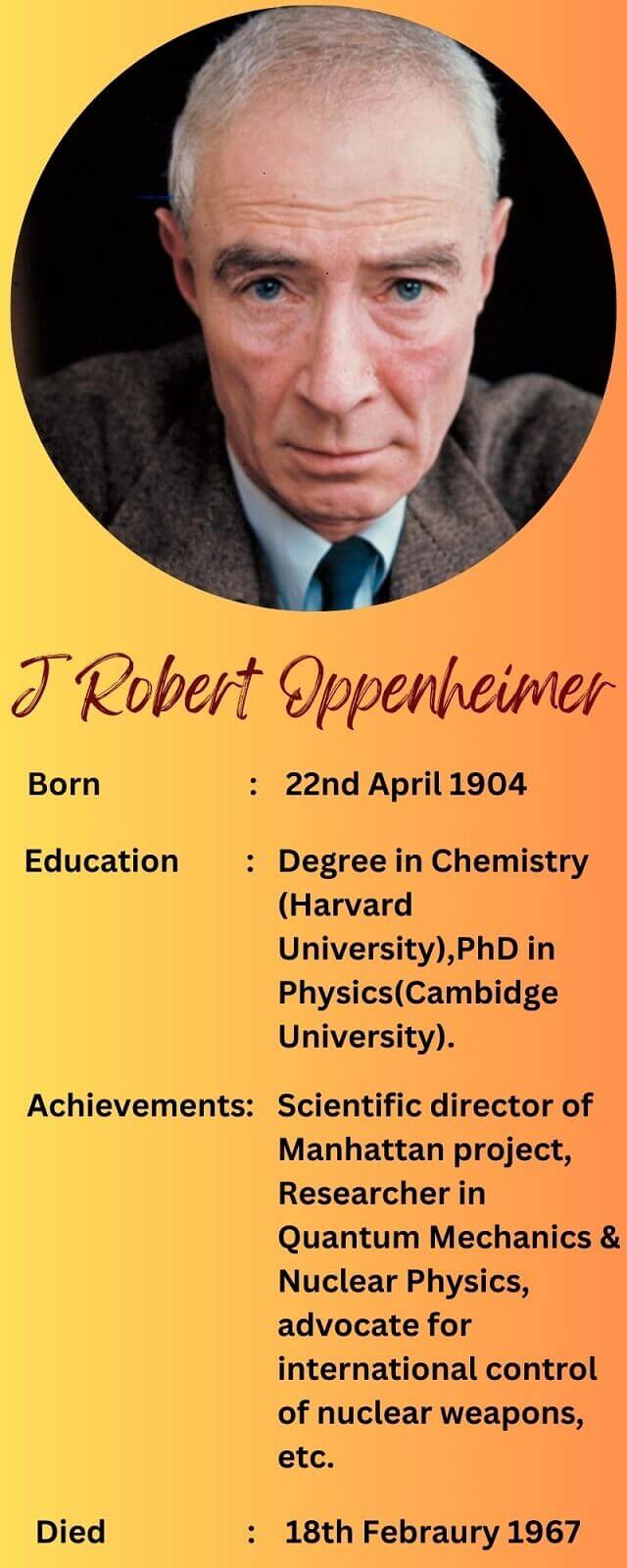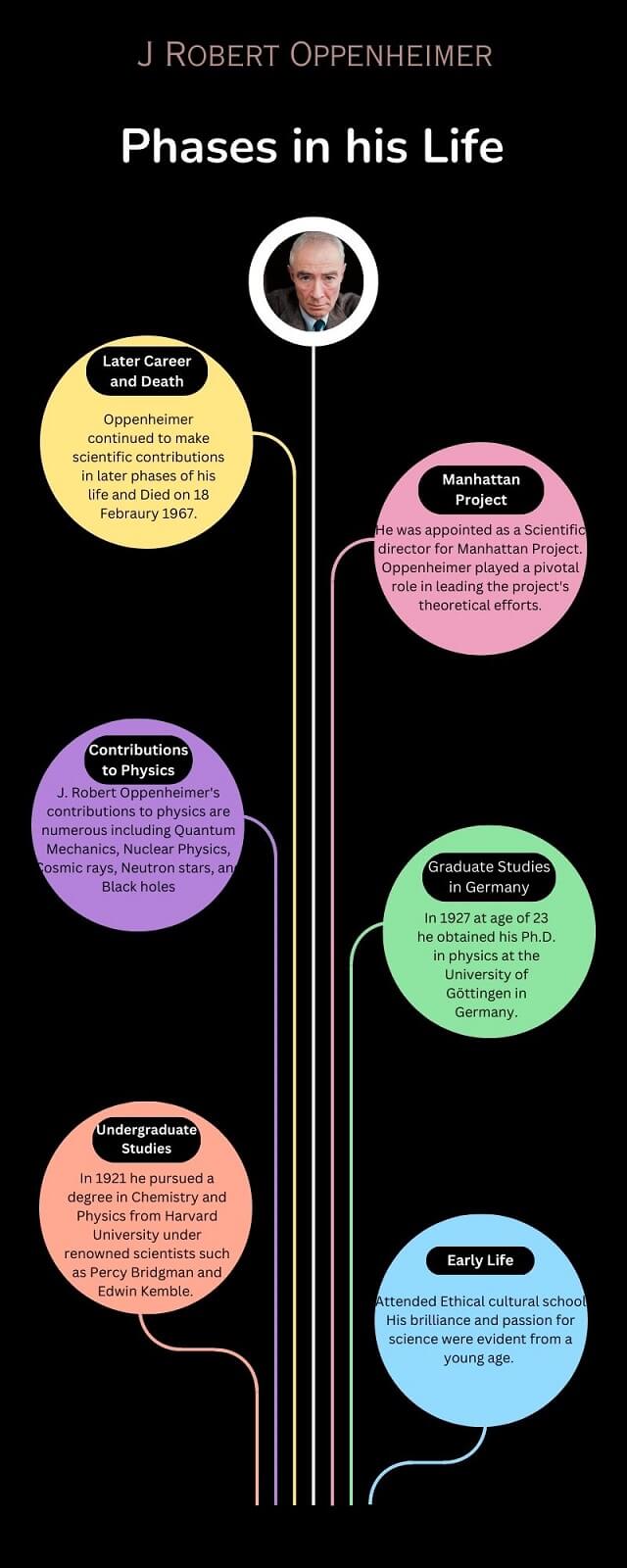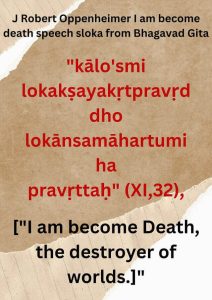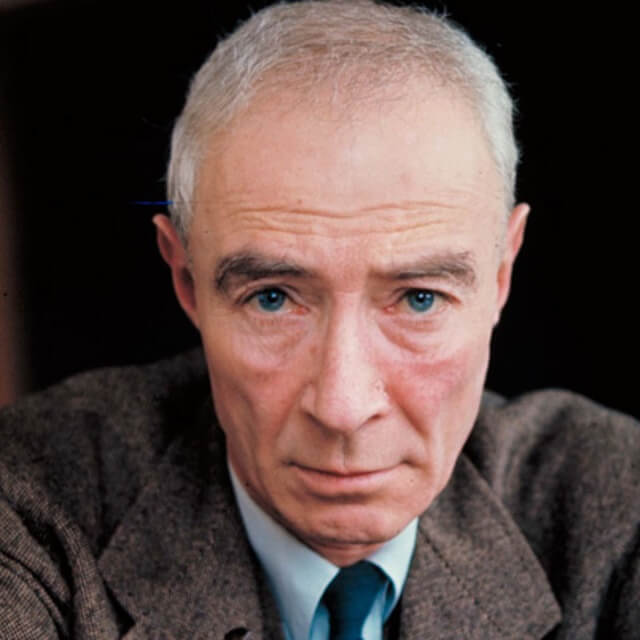J Robert Oppenheimer was a pioneering physicist and visionary leader. His great knowledge and curiosity to learn new things led to the development of the atom bomb and his contributions and innovations to the field of physics. In the realm of physics, he stood as a catalyst for many future discoveries in the field.

Robert Oppenheimer is one of the leading members of the Manhattan Project, a programme to develop the atomic bomb. He also made significant advancements in theoretical physics and quantum mechanics, becoming known for his expertise in the field.
In this article, we will learn about a man of many talents, Robert J Oppenheimer, his early life and education, his role in the development of the atomic bomb, and his contributions to the field of physics and nuclear research.
Robert J Oppenheimer Early life, education, discoveries, the Manhattan Project, facts, and quotes
Robert J Oppenheimer was an exceptional figure in the field of physics and a prominent scientist of his time. His contributions to science, particularly his role as the scientific director of the Manhattan Project, elevated him to a position of great importance in history.

Robert Oppenheimer’s childhood:
Robert J. Oppenheimer was born on April 22, 1904, in New York City to Jullis Seligmann Oppenheimer, a German immigrant who had established a textile importing business, and Ella Friedman, a painter. Oppenheimer has a brother and a sister. Since childhood, Oppenheimer has been a voracious and fast learner. He was extremely socially awkward as a teenager, so he didn’t have real friends and was the loneliest person.
Oppenheimer did his schooling at the Ethical Culture Society School. He completed his third and fourth grades in the same year and his eighth grade in a half-year. When he was 5, he went on a vacation to his grandfather’s house in Germany. There, he became enamoured with the collection of minerals his grandfather had given him. And he developed a lifelong obsession with rock collecting. When he was 11, he joined the New York Mineralogical Club, and a year later he presented his first scientific paper.
J Robert Oppenheimer Education:
Oppenheimer’s undergrad years began at Harvard University in the 1920s. At that time, he was especially interested in chemistry and earned a degree in chemistry from Harvard University. Everyone who studies science at Harvard University should definitely study literature, history, and philosophy as well. During this time, Robert read the English version of the Bhagavad Gita, a Hindu scripture. Later he learned Sanskrit to read it in the original language.
Robert found Percy Bridgeman’s experimental physics classes at Harvard to be appealing. In 1924, Oppenheimer was admitted to the Cavendish Laboratory at the University of Cambridge. He requested permission from Ernest Rutherford to work at the Cavendish Laboratory. Bridgman gave Oppenheimer a recommendation that made it clear that Oppenheimer’s clumsiness in the laboratory meant that his forte was not experimental but theoretical physics.
But Oppenheimer got a good opportunity to work with a research team under the leadership of J.J. Thomas, who discovered the electron in 1897. In 1926, Oppenheimer left Cambridge and entered the University of Gottingen to pursue a PhD in physics under the supervision of Max Born.
Oppenheimer’s doctoral studies primarily focused on quantum mechanics; he delved into theoretical aspects, exploring the mathematical formulations and conceptual frameworks that underpin quantum theory. And finally, in 1927, at the age of 23, Oppenheimer obtained his PhD in physics.
J Robert Oppenheimer and the Manhattan Project
The United States started the Manhattan Project during World War II to create nuclear weapons and the atom bomb. Oppenheimer played a central role in the development of the atomic bomb during the Manhattan Project. In 1942, the United States government appointed Oppenheimer as the scientific director of the Manhattan Project.
Making good use of his theoretical physics knowledge, he correctly guided the team through the challenges faced while developing the atom bomb, including the fundamental understanding of nuclear reactions, neutron moderation, and critical mass calculations.
Under Oppenheimer’s leadership, on July 16, 1945, the Manhattan Project successfully test-fired the first atomic bomb under the code name “Trinity” in the New Mexico desert. The atomic bombs developed in this Manhattan project were dropped on Hiroshima and Nagasaki. The devastating impact of these bombings hastened Japan’s surrender, effectively ending World War II.

J Oppenheimer and the Bhagavad Gita
Oppenheimer has a profound connection with the Bhagavad Gita, a Hindu scripture. He was introduced to the Bhagavad Gita when he was studying at the University of Gottingen in Germany by his friend Arthur W. Ryder. He devoted a lot of time to studying its philosophical texts, which were particularly fascinating when it came to duty, moral responsibility, and the nature of life and death.
Oppenheimer’s work on the Manhattan Project is closely related to some of the lessons in the Bhagavad Gita. In a conversation with journalist Richard L. Stokes after the Trinity Test, he famously quoted a verse from Chapter 11, Verse 32, of the Bhagavad Gita: “Now I am become Death, the destroyer of worlds.” The quote reflects the profound impact it had on him during the development of the atom bomb.

This verse has a wider context in the Bhagavad Gita, where Krishna gives the warrior Arjuna profound teachings on the importance of fulfilling one’s duty regardless of the results. By invoking the Bhagavad Gita, Oppenheimer symbolically connected his role in the creation of the atomic bomb with the moral dilemmas that Arjuna faced during the war.
Discoveries of Robert J Oppenheimer
Apart from being the director of the Manhattan Project, he made significant discoveries and contributions to the field of physics. His discoveries and contributions spanned various areas of physics, from astrophysics to quantum mechanics. Here are some of his notable discoveries and contributions to physics:
Oppenheimer-Phillips Process:
Together with his student Melba Phillips, Oppenheimer developed the Oppenheimer-Phillips process, which explained the mechanism behind nuclear reactions in stars. This process played a key role in developing our understanding of stellar nucleosynthesis.
Oppenheimer-Volkoff Limit:
Oppenheimer, along with physicist George Volkoff, made groundbreaking contributions to the study of neutron stars. They proposed the Oppenheimer-Volkoff limit, which describes the maximum mass a neutron star can sustain before collapsing into a black hole under the influence of gravity.
Quantum Tunnelling:
Oppenheimer’s work in quantum mechanics contributed to the understanding of quantum tunnelling. He explored the phenomenon of cells overcoming potential barriers, leading to insights into the behaviour of subatomic particles.
Oppenheimer-Snyder Model:
In 1939, Oppenheimer, along with his student Hartland Snyder, published a groundbreaking paper exploring the gravitational collapse of massive stars. Their model, called as the Oppenheimer-Snyder model, assumes that a massive star collapses under its own gravity, forming a dense region.
Oppenheimer-Phillips Effect:
Oppenheimer and Phillips also made significant contributions to the theory of electron-positron pair production in high-energy gamma-ray interactions. This phenomenon, known as the Oppenheimer-Phillips effect, has helped explain the formation of particle-antiparticle pairs under extreme conditions.
Interesting facts about J Robert Oppenheimer
- In 1939, Oppenheimer, together with his graduate student Hartland Snyder, made a significant contribution to the study of gravitational collapse, a key process in the formation of black holes. Albert Einstein’s theory of relativity had an impact on his work in this area.
- After the Manhattan Project ended, Oppenheimer continued his scientific and academic activities. He became an advocate for international control of nuclear weapons and also played a leading role in shaping science policy and education in the United States.
- Oppenheimer had a keen interest in languages and was fluent in several, including Sanskrit, German, French, and Spanish. His language skills allowed him to delve into a wide range of literary and philosophical texts from different cultures.
- Oppenheimer founded and directed the Los Alamos Laboratory in New Mexico, where much of the research and development work for the atomic bomb took place.
- There are many films and documentaries that explore the life and work of Oppenheimer, shedding light on his role in the development of the atomic bomb and his subsequent contributions to science. Fat Man and Little Boy (1989), The Day After Trinity (1980).
- There is a popular claim that J. Robert Oppenheimer’s IQ is 200. However, it is important to note that this claim is baseless and lacks convincing evidence. IQ scores above 160 are rare and are often attributed to highly gifted individuals. A score of 200 exceeds the highest recorded IQ score.
- Oppenheimer was nominated for the Nobel Prize in physics on several occasions. Oppenheimer’s nominations were primarily for his work on quantum mechanics and his leadership of the Manhattan Project during World War II.
J. Robert Oppenheimer quotes
“The world has achieved brilliance without wisdom, power without conscience. Ours is a world of nuclear giants and ethical infants.”
“There must be no barriers for freedom of inquiry. There is no place for dogma in science. The scientist is free, and must be free to ask any question, to doubt any assertion, to seek for any evidence, to correct any errors.”
“I do not know how the Third World War will be fought, but I can tell you what they will use in the Fourth!”
“The optimist thinks this is the best of all possible worlds. The pessimist fears it is true.”
“The physicists have known sin; and this is a knowledge that they cannot lose.”
J Robert Oppenheimer Achievements:
Robert J Oppenheimer achieved numerous significant milestones throughout his career. Here are his notable achievements:
Manhattan Project:
Oppenheimer’s most famous achievement was leading the Manhattan Project, the World War II research and development programme that produced the first nuclear weapons. Oppenheimer was the scientific director of the project and provided critical guidance and supervision for the scientific research and engineering efforts that led to the creation of the atomic bomb.
Quantum Theory:
Oppenheimer was a leading researcher in the field of quantum mechanics, the branch of physics that describes the behaviour of matter and energy at the most fundamental levels. His work contributed significantly to the development of the theory of quantum electrodynamics, which is now one of the most fundamental pillars of modern physics.
Nuclear Physics:
Oppenheimer made several important contributions to the study of nuclear physics, including the physics of neutron stars, cosmic rays, and the atomic nucleus.
Advisor to the U.S. Government:
After World War II, Oppenheimer joined the U.S. government as a scientific advisor and played a key role in the development of national defence policies and the governance of scientific research in the post-war period.
Scientific Adviser
After the Manhattan Project, Oppenheimer became an influential scientific advisor. He served as chairman of the Atomic Energy Commission’s General Advisory Committee and the U.S. He played a key role in developing the nuclear policy.
J Robert Oppenheimer awards and honours
Oppenheimer received numerous awards and honours throughout his career, some of which include the Enrico Fermi Award in 1963, the National Medal of Science in 1964, the Franklin Medal in 1951, and the Prix Mondial Cino Del Duca in 1965.
J Robert Oppenheimer cause of death
Robert J Oppenheimer passed away on February 18, 1967, at the age of 62. The cause of his death was found to be complications related to throat cancer. Oppenheimer was diagnosed with the disease in 1965. He underwent several treatments including surgery and radiation therapy to combat it, but it eventually spread and caused his death.
FAQ’s
- Did j Robert Oppenheimer regret
As Oppenheimer played a central role in the development of the atomic bombs, after the bombings of Hiroshima and Nagasaki, Oppenheimer regretted the use of the atomic bomb. The moral ramifications of his work haunted him as he recognised its devastating effects on the Japanese people and the rest of the world.
- Where was j Robert Oppenheimer born?
Robert J Oppenheimer was born on April 22, 1904, in New York City to Jullis Seligmann Oppenheimer, a German immigrant who had established a textile importing business, and Ella Friedman, a painter.
- How did J Robert Oppenheimer make the atomic bomb?
It is important to note that Oppenheimer did not invent the atomic bomb himself. He played a key role in its development as the scientific director of the Manhattan Project. Oppenheimer’s leadership, scientific expertise, and organisational skills certainly made this project a success.
- What did J Robert Oppenheimer discover?
Oppenheimer is best known for his role in developing the atomic bomb as part of the Manhattan Project. However, he also made several other important discoveries in the field of theoretical physics during his life. Some of them include quantum theory, nuclear physics, the Oppenheimer-Phillips process, and many others.
- Why did J. Robert Oppenheimer create the atomic bomb?
The geopolitical setting of World War II, scientific research, and the need for national security, above all had an impact on Oppenheimer’s development of the atomic bomb.
Conclusion:
In conclusion, Robert J Oppenheimer was an extraordinary physicist. Oppenheimer’s contributions to physics, his leadership during the Manhattan Project, and his reflections on the implications of the atomic bomb cemented his place in history as a brilliant scientist who had a lasting impact on the world. His death marked the end of a brilliant scientific career that had a profound impact on the development of physics and nuclear technology. Thank you for reading for more articles visit Techy Robo.
